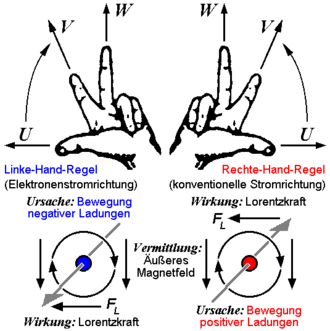Three-finger rule
The right-hand rule is a rule of thumb for determining the relative orientation of three over the cross product related vectorial quantities . The rule is usually formulated to fit the right hand, which is why it is also known as the right-hand rule .
geometry
The orientation of the vector, which results from the cross product in three-dimensional space, is illustrated by the thumb of the right hand pointing in the direction of the vector and the index finger in the direction of the vector . The thumb and index finger are on the same level as the palm. The middle finger protrudes 90 ° and points in the direction of the vector resulting from the vector product (see picture above).
This can also be used for the orientation of orthogonal coordinate systems. Since a cyclic permutation of the order of the vectors is harmless, z. B. with unit vectors:
Direction of angular momentum
When rotating a body, the usually defined direction of rotation (counterclockwise) of the angular momentum results in the same way from the cross product of the radial vector with the tangential velocity . The right hand represents the center of rotation, the thumb points radially outwards and the index finger in the direction of movement tangential to the point at which the thumb points. The middle finger then determines the direction and thus the sign of the angular momentum. The rule also applies to cyclic permutation: the thumb points in the direction of the angular momentum, the index finger points away from the center of rotation along the radius and the middle finger shows the direction of the tangential movement. The angular momentum is an axial vector that represents the plane of rotation and the direction of rotation.
Electromagnetism and Electrical Engineering
In the context of electromagnetism, the memory rule is also known as the UVW ("cause-mediation-effect") rule or, according to the size symbols of the vector quantities that occur , as the IBF or FBI rule .
Example: Procedure for determining the deflection of a current-carrying conductor in a magnetic field ( conductor swing test):
- The outstretched right thumb follows the technical direction of the current , i.e. the direction of movement of positively charged charge carriers or the opposite direction of movement of negative charge carriers.
- The outstretched right index finger follows the direction of the magnetic field lines , i.e. the direction in which the north pole of a test magnet is aligned.
- The bent right middle finger (perpendicular to the index finger) points in the direction of the Lorentz force .
The following applies to the Lorentz force :
( : Charge of the particles on which the force acts, in the case of electrons) or
( : current-carrying section of conductor)
To determine the direction of the magnetic field of a current-carrying coil, see the right-hand rule .
There is also the “left-hand rule” or “left-fist rule”, which is based directly on the direction of movement of the electrons. As the adjacent figure shows, these rules work analogously to the rules of the right hand, but no longer based on the conventional or "technical" current direction , but the movement of the electrons, which is particularly useful when examining the movement of negatively charged particles such as conduction electrons or cathode rays , since in this case one is looking for an imaginary direction reversal of the charge carrier movement and mathematically for the negation the charge in the Lorentz formula, see above). Due to the traditional predominance of the right-hand rule, however, many people perceive the left-hand rule as an additional rule that confuses them more than it supports them, all the more since school lessons are also very inconsistent with its teaching.
Memory rule formulations
- UVW rule
The thumb points in the direction of the cause , in the example in the technical direction of the current or the direction of movement of the positive charge (and thus against the direction of movement of the electrons).
The index finger points perpendicular to the thumb parallel to the magnetic field lines , i.e. the mediation (also linking ), the magnetic field .
The middle finger points at right angles to the thumb and index finger in the direction of the effect , the Lorentz force .
On the other hand, the cause can also be the relative movement of the conductor in the magnetic field. The effect in this case is the forced movement of electrons along the conductor, called electromagnetic induction of an electric current.
- FBI or IBF rule
IBF (" Ich bin Franz ") or FBI : The first letters of the variables involved are used for the memory rule. The thumb stands for the current and shows the technical direction of the current. The index finger represents the magnetic field and points in the direction of the magnetic field. The middle finger shows the direction of the acting Lorentz force . If the letters FBI are reversed , the fingers must also be enumerated in reverse order; the assignment of the fingers to the physical quantities must not be reversed.
Trivia
The three-finger rule is shown on the 200-franc banknote from Switzerland, which has been issued since 2018, as a symbol for the coordinate system.
Web links
- Information on the subject (State Education Server Baden-Württemberg)
- Three-finger rule at student level ( LEIFIphysik )
swell
- ^ Dorn-Bader: Physics in one volume . Schrödel, 2006, ISBN 3-507-86266-2 , p. 291.


















